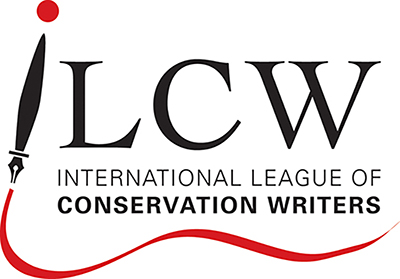______________
News
12th World Wilderness Congress * the Black Hills, USA *
Aug 25-31, 2024

For more information: www.wild.org/wild12
. . . . . .
Minden Pictures Photo Embeds for Free
Specialty stock photo agency Minden Pictures represents top wildlife and nature photographers, including many National Geographic freelancers. Minden Pictures has partnered with SmartFrame Technology to release a collection of over 140,000 fully-licensed images as photo embeds that can be freely posted to blogs and websites and shared on social media. The intent behind this new product launch is that access to premium images at no cost can help conservation and science writers make their online posts more compelling and their messaging more effective. Minden Pictures Embeds are streamed still images that may be posted and shared as easily as a YouTube video by copying and pasting code into your HTML editor. When shared to social networks, an eye-catching thumbnail links back and drives web traffic to your original post. You can use embeds in current projects or refresh existing posts. Embeds may be used in any context except for selling products or services.
If this resource is of interest, you can learn more about Minden Pictures Embeds at the following links:
Photo Embeds - What are they and how do they work
Introduction to Minden Pictures Embeds by SmartFrame,
Browse the Minden Pictures Embed collection
Sample Photo Embed published in an online textbook
Questions or comments are welcome. Reach out to Robbie Schmelzer (ILCW Associate, USA), Minden Photo Embed Guy, +1-808-747-6476. Or callrob@gmail.com.
. . . . . .
Green Podcasts
Green Radio Hour with Jon Bowermaster, this podcast features Pete Lopez (Scenic Hudson) on the future of PCBs in the Hudson Valley, New York (USA).
Rewilding Earth Podcast featuring Liz Hillard discussing Wildlife Connectivity in the Pigeon River Gorge, corridor of the Great Smoky Mountains National Park in North Carolina and Tennessee (USA). Regarding the redesign of bridges and other barriers to accommodate wildlife.
. . . . . .
Poetry in an age of ecological crisis
(ILCW member Elizabeth Herron is poet laureate of Sonoma County, California, USA. She shared this article with ILCW)
Graton poet Elizabeth Herron writes poems about the natural world in crisis
By Mark Fernquest

It’s a busy time for Graton, California writer Elizabeth Herron. As Sonoma County’s Poet Laureate for the 2022-24 term, literary events, local functions and her signature ‘Being Brave’ classes keep her schedule full.
“Being poet laureate for me is an act of service; it’s a way of giving back, and it’s a way of expanding the role of poetry in our lives,” she said.
Born in Chicago and raised in Hawaii, Herron earned a master’s in counseling at San Francisco State University, then studied biopoetics, earning a doctorate in psychology from the University for Integrative Learning. After a stint at San Francisco State University, she worked at Sonoma State University, first at the counseling center and later in the creative writing department.
A pivotal moment in her life occurred in 1991 when she witnessed firsthand the devastating environmental damage wrought by the Dunsmuir Spill, in which a train accident leaked 19,000 gallons of deadly herbicide into the Sacramento River. The chemical impact reached all the way to Lake Shasta, 20 miles downstream.
“I became conscious about what was happening to the natural environment,” Herron said of the experience.
Though she lived in West County by then, the incident galvanized her to dedicate a decade of her life and work to the study of wild trout and salmon and threats to their survival and, later, to climate change. Today the topic of climate crisis infuses her writing, and she tirelessly advocates for nature through her essays, poems and readings.
Her poems, she said, “come first and foremost out of my heart, and my heart takes me to a deep, deep concern for what’s going on around me, what’s happened to the planet, what’s going on with the climate and how that’s affecting all life.”
An essayist and poet, Herron’s work has appeared in literary journals and magazines including Reflections, West Marin Review, Free State Review, Silk Road, Orion, Parabola, Ions, Comstock Review, Eco-Citizen and Jung Journal, as well as numerous anthologies. She has also published several books.
Her latest published book, In the Cities of Sleep (Fernwood Press, 2023), is her contribution to EXTRACTION: Art on the Edge of the Abyss, a global creative project dedicated to exposing all forms of extractive industry and consisting of 50 intertwined exhibitions and events. A collection of climate-crisis poems, her book addresses the bigger picture of dwindling resources and resulting discord in our rapidly warming world, pushing us, as humans, to look for more viable alternatives to our present path.
Herron initiated the Being Brave Poetry Project when she assumed the role of local poet laureate in 2022.
“As Poet Laureate I offer workshops to foster the writing of being brave poems where people who may never have written a poem before can find words for what being brave means in their lives,” she said. “The workshops include conversation about what our poems tell us of what it means to live courageously. Along with each workshop a reading can be arranged.”
She continued, “I have been a student of Carl Jung’s work and I’m not a Buddhist, but I have read Buddhist texts and commentaries. So it’s all part of what I bring with me. But I think mostly what I bring is my own willingness to be open and vulnerable. That’s part of what makes the workshops come to life. And I think to be brave, we have to have company. We need each other.”
The three-hour workshops are designed for groups of 5 to 25 people. Each includes an introduction with samples of being brave poems, time for writing, time for sharing and facilitated conversations. Herron holds them in various locations, including at Sebastopol Center for the Arts and the Occidental Center for the Arts. Interested parties can contact her directly with questions or requests via her websites at www.elizabethherron.net or www.elizabeth-herron.com.
The classes have proven meaningful to both her and the students.
“There has been such a level of connection and intimacy with one another and [with] me,” she said. “I feel part of that, and it’s such a privilege. To be with people when they are open and in that kind of deep way where we talk about where our courage is, where our fears are. Because, you know, you can’t be brave without being scared.”
She added, “I think it’s been very successful. It’s kept me really busy. That period of time has been wonderfully busy. Sometimes two workshops a month; all together, probably 10 or 12 workshops so far. And they’re in different parts of the county — in bookstores, in private homes, in churches. That’s fine with me. I’ll work anywhere where people want me to come.”
Her advice for young writers?
“Write every day. Ten minutes, five minutes, so that writing is a habit so that when you are ready for the graced material that comes to you from the muse or outer space, you are ready; you have your chops,” she said. “I write first for myself. Some of us writers, we’re led first to writing to find something in ourselves we wouldn’t find any other way.”
What’s next for Herron, after her busy sojourn as Sonoma County Poet Laureate ends, in the summer of 2024? Perhaps a return to solitude is in order.
“Poetry is the solitary art and so [it provides] lots and lots of aloneness and time to reflect, which is the thing that I probably miss a little,” she said. “I’m generally used to a little more of that than I have these days. But I’ll have it back.”
This article is from the Sebastopol Times, a reader supported publication. For more information about the on-line journal https://www.sebastopoltimes.com/
Elizabeth Herron can be reached at: EHsocopoetlaureate@gmail.com or www.elizabeth-herron.com
_________________
Member Writing
Assorted Stories
By Meera Subramanian (USA) Fellow
 ILCW member Meera Subramanian, has two recently published articles, one in the New Yorker and in Orion magazine. The New Yorker article, Consider the Vulture, was a long time in the making, about the recovery of vultures in South Asia after a catastrophic decline, funded by a National Geographic Storyteller grant. Click here to read. ILCW member Meera Subramanian, has two recently published articles, one in the New Yorker and in Orion magazine. The New Yorker article, Consider the Vulture, was a long time in the making, about the recovery of vultures in South Asia after a catastrophic decline, funded by a National Geographic Storyteller grant. Click here to read.
The Orion article, An Amazing 200 Million Year-Old Race, is about a release of baby sea turtles on the shores of Mexico. Read about it here.
More of Meera’s writing can be found here.
Restless at My Writing Desk
By Michael McBride (USA) Fellow
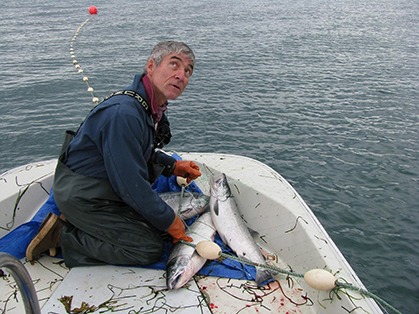 **Feeling restless at my writing desk one day, I reached out for the neolithic stone hammer that I had found a few days earlier below the lower pasture. It was about to be swept away by the meandering flow and buried again under some downstream sand bar, not to see the light of day for a thousand years. At times like this when I am looking for lap-top endurance or light-hearted inspiration, it spoke to me in its basaltic tongue and bid me come again down-pasture and trade my computing brain for the mindset of the person who had made it. His voice was clearly heard intermingled with the river’s’ pulse. He told me that a simple walk to a river offers discoveries, real and imagined that can change your life’s perspective. It requires only that you be aware, mindful and open minded. To know this and respectfully return the artifact to the earth and its makers from whence it came, is to know them and the beat of your own heart and to be thus, completely alive. **Feeling restless at my writing desk one day, I reached out for the neolithic stone hammer that I had found a few days earlier below the lower pasture. It was about to be swept away by the meandering flow and buried again under some downstream sand bar, not to see the light of day for a thousand years. At times like this when I am looking for lap-top endurance or light-hearted inspiration, it spoke to me in its basaltic tongue and bid me come again down-pasture and trade my computing brain for the mindset of the person who had made it. His voice was clearly heard intermingled with the river’s’ pulse. He told me that a simple walk to a river offers discoveries, real and imagined that can change your life’s perspective. It requires only that you be aware, mindful and open minded. To know this and respectfully return the artifact to the earth and its makers from whence it came, is to know them and the beat of your own heart and to be thus, completely alive.
Aldo Leopold describes in his poetic Sand County Almanac a riverside farm behind which the farmer has a “library” of books, old boards carried downstream by the flow and gently deposited on the curving sandbar near at hand here he found them. Like fingerprints, each carries some assignation of who used it upstream and to what purpose? The farmer studied each piece, wondering at its use based on nails or lack of them, saw cuts, holes drilled and abrasions which might tell of its travels from distant lands. Deciding that there was still some utility aboard, he carried the treasure, long or short, thick or thin, to the backside of the barn. There he marries it to the existing collection so that in some mid-winter tinkering in the barn-shop, he might pluck it out of the snow to find a new utility that started as a seed and a sapling and became a log for the sawmill. Reading books can be turning pages at fireside, or plucking an old friend out of the snow.
_________________
Member News
Do you have news?
Let us know if you have won an award, written a new book, or launched a creative endeavor to bring awareness to conservation. Chances are the ILCW membership is not aware of these things, so be sure and tell us. Send items to:patty@ilcwriters.org
. . . . . . . . . . . . . . . . . . . . . . . . . . . . . . . . . .
TOP |
____________________
New Books by
ILCW members
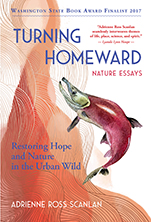 Turning Homeward, 2nd Edition Turning Homeward, 2nd Edition
Restoring Hope and Nature in the Urban Wild
By Adrienne Ross Scanlan
2023, ARS Books, Paperback and Kindle
Grief-stricken after her father's death, Adrienne Ross Scanlan journeys west to seek a new life in a new place. Arriving in Seattle without a job and knowing no one, she encounters the iconic Pacific Northwest salmon in an unlikely place—a Puget Sound suburban creek—and discovers home by helping restore the nature that lives alongside us.
Part memoir, part science-based nature writing, Turning Homeward takes us into the messiness and satisfaction of hands-on restoration, whether it's the citizen science of monitoring coho salmon die-offs in a Seattle creek or relocating a bumblebee hive. Along the way, Scanlan explores the real-world paradoxes of repairing home, such as when one nonnative transplant (Scanlan) yanks out another (Himalayan blackberry) to create habitat for native plants, or the opposing needs of homeless people versus birds, who both seek refuge in a beloved city park.
What Scanlan learns about nature's resilience and the Jewish concept of tikkun olam (repair of the world) sustains her when her beloved daughter is born premature.
In lyrical writing that engages but never preaches, Turning Homeward's heartfelt union of science and spirit shows that restoring the nature close to our lives also restores our courage, joy, and hope for the future.
. . . . . .
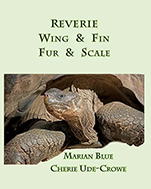 Reverie: Wing & Fin, Fur & Scale Reverie: Wing & Fin, Fur & Scale
By Marian Blue (poetry) and Cherie Ude-Crowe (photography)
2023, Sunbreak Press, 8x10, 129 pages, hardcover and paperback
What a generous gift Reverie is to all of us sharing this planet with flora, fauna, land, sea, and sky. To have these poems and photographs together is like winning two lotteries at the same time. Cherie Ude-Crowe’s eye for composition, light, and subject is awe-inspiring. Ever stellar poet Marian Blue’s wit, wisdom, and well-honed skills build powerful poems, and in particular, their sonic structures are a thing of aural beauty. This book is truly a feast for eyes and ears! The poems and photographs moved me deeper into an appreciation of our beautiful home, even as many are a call to respond to eco-collapse in these dire times. I admire how each animal is an individual to be seen and heard, and how the land herself has a voice here. In the sweeping, expansive poem Berg, Blue writes: “Earth:/alive, ever creative, ever changing,/challenging everything she shelters –/adapt, evolve, protect, and revere.” Truly, each time I reread this book, I find another gem of a line or see something anew in a photograph. Even the forward is in essence an Ars Poetica: “The trick is to notice your world during and between blinks. See the living and dying; feel the air cooling and heating; smell the suggestions of rain and wildflower blooms; hear frogs and birds and coyote songs; taste fear when the unexpected sparks adrenalin. This is magic, mystery, spirituality, joy, and infinite blessings rolled into daily life.”
—Malaika King, author/editor
. . . . . .
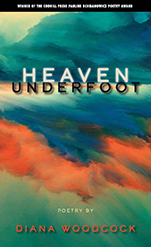
Heaven Underfoot
By Diana Woodcock
2023, Codhill Press
Paperback, 86 pages, 5x5 x 9
Winner of the 2022 Codhill Press Pauline Uchmanowicz Poetry Award.
The speaker of the poems in Heaven Underfoot—by immersing herself in the more than human world of several diverse biomes, from the Arabian Desert to the Everglades, Southern Africa, the Arctic Circle, Great Smoky Mountains, and the Tongass National Forest—has endeavored to make the non-human environment central rather than marginal as she explores and celebrates the sacred within and on this earth. For more information, go to https://www.codhill.com/product/heaven-underfootdiana-woodcock/
Reviews
In Diana Woodcock’s Heaven Underfoot, we find a beautiful marriage of scientific fact, social understanding and lyric image. This book travels the world with eyes wide open and a generous heart—Africa, Cambodia, the Arabian Desert, the Arctic, the Great Smoky Mountains, the Everglades—and everywhere it goes, it names the world with specificity and music. While acknowledging the imperfection of a human inhabited world, these poems remain awash in gratitude and wonder. They invite us to participate in that wonder and, along with the poet, to “give thanks all day / For the rapture and despair, / For all that is missing / And all that’s still there.”
—Anne McCrary Sullivan, author of Notes from a Marine Biologist’s Daughter
Diana Woodcock’s sixth book of poems, Heaven Underfoot, celebrates the immeasurable abundance, beauty, and strangeness of earth’s creatures in various parts of the world where she lives or has traveled: the Arabian Desert, southern Africa, the Svalbard Peninsula, Florida’s River of Grass, the Great Smoky Mountains, the Tongass. Her immersion in and intimate knowledge of the other-than-human world make the book a rich pleasure. There’s “so much we can’t know,” she writes; yet, “becoming overwhelmed by a sense of your own insignificance, you find it liberating, intoxicating; you feel, for the first time in the longest time, utterly at peace here in the midst of wild things.” And in the poem “Put All America Behind You,” she sounds an urgent note about the environmental peril of our times: “Wander and wonder / on [earth’s] rich mosaic—let her fill in / the gap and bring you back / from the dark brink."
—Ann Fisher-Wirth, author of Paradise Is Jagged and The Bones of Winter Birds, coeditor of The Ecopoetry Anthology and The Ecopoetry Anthology: Volume II (Trinity University Press, 2025)
. . . . . .
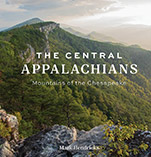 The Central Appalachians: Mountains of the Chesapeake The Central Appalachians: Mountains of the Chesapeake
By Mark Hendricks
2023, Shiffer Publishing, Hardcover
10” x 7.5,” 192 pages, 254 color photos
Beautiful and wild, the Central Appalachians of Maryland, Pennsylvania, Virginia, and West Virginia are a hotspot for biodiversity. They also make up a large part of the Chesapeake Bay watershed and are responsible for a majority of its freshwater flow.
Award-winning author and nature photographer Mark Hendricks spent years documenting life on the mountain trails and underneath Appalachian waters and built camera traps to capture images of rarely seen species. Not only are these images beautiful and fascinating, but they bring more understanding of the environmental importance of the area.
Well-known locations such as Shenandoah National Park are featured prominently, as are little-known areas such as the Finzel Swamp and the famous reintroduced elk herd of north-central Pennsylvania. It’s a wild and wonderful journey for all nature lovers.
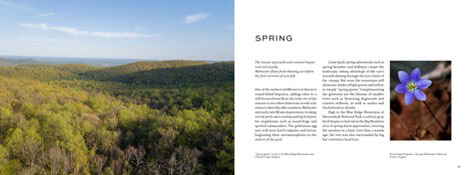
________________
See all Books by ILCW members here
. . . . . . . . . . . . .
TOP |
